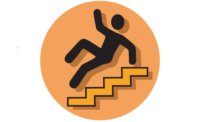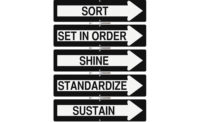Slips happen where there is too little friction or traction between the footwear and the walking surface. According to the CCOHS, common causes of slips are:
- wet or oily surfaces
- occasional spills
- weather hazards
- loose, unanchored rugs or mats
- flooring or other walking surfaces that do not have same degree of traction in all areas
Trips happen when your foot collides (strikes, hits) an object causing you to lose the balance and, eventually fall. According to the CCOHS, common causes of tripping are:
- obstructed view
- poor lighting
- clutter in your way
- wrinkled carpeting
- uncovered cables
- bottom drawers not being closed
- uneven (steps, thresholds) walking surfaces
Good housekeeping, quality of walking surfaces (flooring), selection of proper footwear, and appropriate pace of walking are critical for preventing fall accidents, says the CCOHS.
Good housekeeping is the first and the most important (fundamental) level of preventing falls due to slips and trips. CCOHS says good housekeeping includes:
- cleaning all spills immediately
- marking spills and wet areas
- mopping or sweeping debris from floors
- removing obstacles from walkways and always keeping them free of clutter
- securing (tacking, taping, etc.) mats, rugs and carpets that do not lay flat
- always closing file cabinet or storage drawers
- covering cables that cross walkways
- keeping working areas and walkways well lit
- replacing used light bulbs and faulty switches
Changing or modifying walking surfaces is the next level of preventing slip and trips, according to the CCOHS.
In workplaces where floors may be oily or wet or where workers spend considerable time outdoors, prevention of fall accidents should focus on selecting proper footwear, according to the CCOHS. Consultation with manufacturers' is highly recommended.
Properly fitting footwear increases comfort and prevents fatigue which, in turn, improves safety for the employee, according to the CCOHS.


